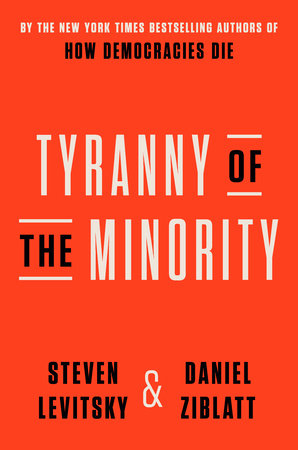by Steven Levitsky and Daniel Ziblatt, 2023
A Review

The authors of this book, who are in favor of a multiracial (probably a multicultural) democracy, show us how the minority in our nation blocks the majority through the filibuster, the Electoral College, “a severely malapportioned Senate”, and a Supreme Court whose members are appointed for life and have the authority to strike down as unconstitutional laws passed by congressional majorities. (pg. 148) They also show how it was the Democratic Party in the South who were the racists from post Civil War to 1965, when the Republicans supported the Voting Rights Act and were anti-racist until 2021, when they unanimously rejected federal legislation to restore it. (pgs. 92, 93)
Levitsky and Ziblatt tell in their Introduction how the January 5, 2021 election of Warnoff (a Black person) and Ossoff (a Jewish person) to the U.S. Senate, with the January 6, 2021 insurrection, displayed “the full promise and peril of American democracy.” (pg. 4)
In Chapter One, the authors describe how various nations have lost their democracy and how some have gained it back
In Chapter Two, they describe in detail how Hungary became authoritarian through specific procedures, some of which I see happening in our nation. This chapter also states, “Politicians who are committed to democracy. . . must always do three basic things.” These are
- respect the outcome of free and fair elections;
- unambiguously reject violence as a means of achieving goals; and
- always break with antidemocratic forces. (pgs. 40, 41)
Then, in Chapter Three they describe in detail how the Black people in post-Civil-War Wilmington, North Carolina had become a successful majority that included business people, physicians, and a lawyer, and who had, after forming the Fusion Party with poor white people, gained a seat in the House of Representatives and many other elected offices. This alarmed the white Democrats, who knew they could not vote them out of office and, as one Democrat acknowledged at a rally, “We must either outcheat, outcount, or outshoot them.” (pg. 68) A militia, supported by the Democratic Party, was formed and, using violent tactics (including burning down the Black-owned newspaper building), the Democrats drove the Black and white Fusionists out of office. The chapter goes on to describe the many anti-Black and anti-poor-white measures enacted by southern Democrats, Congress, and the Supreme Court.
After giving a detailed history of what led up to so many of our citizens supporting Trump and Trumpism, Levitsky and Ziblatt give and substantiate as the cause: the fear of a coming Black majority. They also cite the role of the “great replacement theory”—the fear of immigrants and Jews replacing America’s “native” white population. However, they also point out that these fears did not start with Trump, but were around with the Tea Party, the Birch Society, and McCarthy.
They declare, “Democracies cannot survive without some essential counter-majoritarian institutions. But they also cannot survive—at least as democracies—with excessively counter-majoritarian institutions. And this is where the United States finds itself today.” (p. 147)
The titles of Chapters Five, Six, and Seven—The Fettered Majority, Minority Rule, and America the Outlier—describe their contents very well.
Then, having explained in Chapter Seven that our Constitution (even with its amendments) is old (unlike the constitutions of other current democracies), Levitsky and Ziblatt tell us what changes they believe should be made to save our democracy. First, though, they describe the arduous paths taken by past advocates for democracy to obtain women’s suffrage, citizenship and voting rights for Native Americans, the right to vote for D.C. citizens, the elimination of the poll tax, and the lowering of the minimum voting age to 18.
The changes for which they advocate are
- for the House of Representatives and State Legislatures, a form of proportional elections in which seats are allotted according to population;
- reforming the Senate so that the number of Senators elected from each state is more proportional to its population;
- abolishing the filibuster;
- establishing term limits for Supreme Court Justices:
- a constitutional amendment establishing the right to vote for all citizens;
- establishing automatic registration to vote;
- expanding early and mail-in voting;
- holding Election Day on a Sunday or making it a national holiday;
- restoring voting rights (without additional fines or fees) to ex-felons who have served their time;
- restoring national-level voting-rights protection. (pg. 232)
The authors know that these seem and probably are difficult to achieve, but they describe in great detail the large number of volunteer groups (including some right-of-center) working to do just that.
They remind us that “standing up for democracy means standing up for ourselves” and that “building a truly multiracial democracy falls upon us.” (pgs. 255, 256)
Find The Tyranny of the Minority here.
